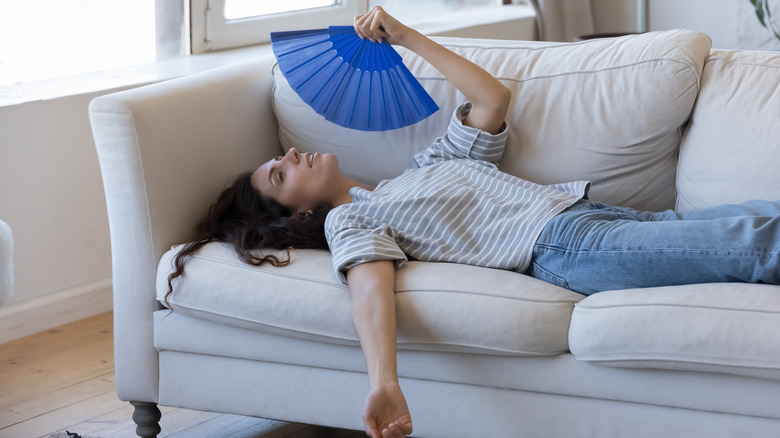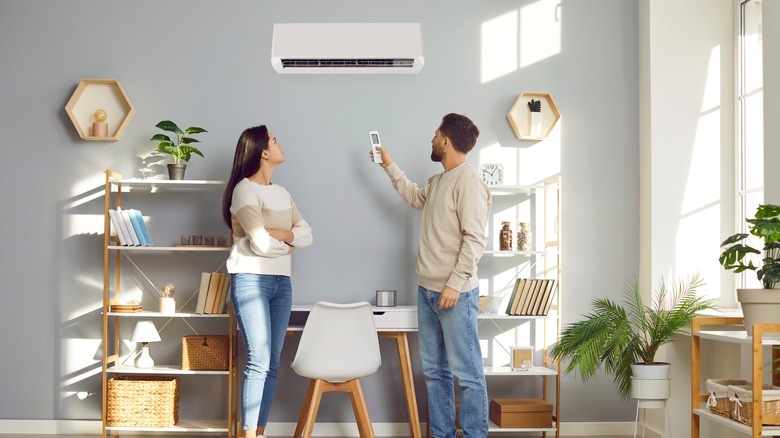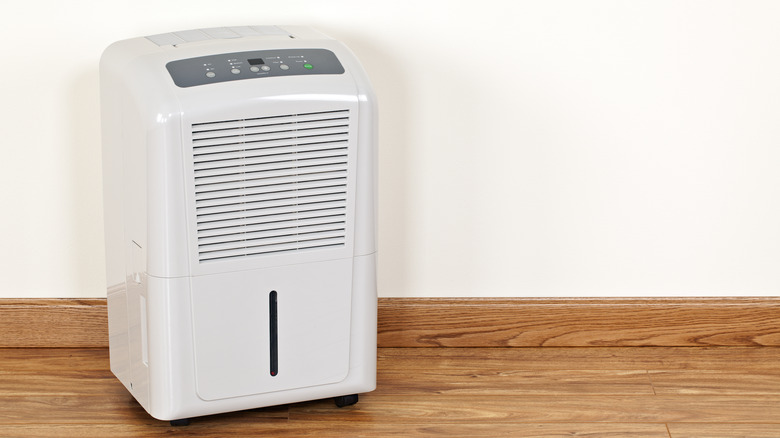The Fastest Ways To Dehumidify Your Home In The Summer
Unless you live somewhere dry like Las Vegas, Tucson, or Phoenix, you've probably dealt with plenty of those uncomfortable hot and humid summer days. Humidity isn't so bad when you can cool off at the beach or in a swimming pool, but when there's a lot of it inside your home, it's much less tolerable. In addition to causing physical discomfort, it can damage certain items and surfaces in your home if the moisture percentage in the air is high enough. The good news is, you can start to dehumidify your home in less than 20 minutes by running an air conditioning (AC) unit, or by using a whole house dehumidifier — if you don't mind waiting longer.
Although an air conditioning unit's primary purpose is to lower the temperature, it can also lower the humidity in a room. A dehumidifier, as the name reveals, removes moisture from the air (dehumidifies), but without changing the air temperature. Both can create a comfortable, healthy humidity level in your home. The United States Environmental Protection Agency recommends keeping the humidity level inside your home between 30 and 50%.
Run your air conditioner to dehumidify your home during summer
Regardless of what type of air conditioner you have (central, window, portable, etc.), it has the capacity to make and keep your home cool while also reducing the amount of humidity. Just be sure to set the thermostat to the "Auto" setting. Some units also include a setting that allows you to reduce humidity levels without cooling your home. This latter setting can benefit residents in areas with high humidity and relatively low summer temperatures, like Alaska.
Air conditioning units dehumidify areas by first pulling the warm air from your home and transferring it outside via a coolant called refrigerant. During this process, the air temperature decreases as it runs over cold evaporator coils in the unit. While the AC absorbs warmth, it also absorbs air moisture. The result? Dehumidification.
It's important to note, though, that various factors can affect the efficiency of the dehumidification process. For example, if your evaporator coils or filters are dirty, the AC unit is too small or too large, or the fan is set to the "On" setting, you may notice only a minimal reduction in humidity, if any at all. Otherwise, you can expect a noticeable drop in the humidity level after about 15 minutes.
Use a whole-house dehumidifier
If your AC is ineffective at removing enough humidity from your home, or if your goal is only to dehumidify and not decrease the air temperature, a whole house dehumidifier will do the trick. Whole house dehumidifiers are designed to remove moisture in the air from a large space, with some units capable of dehumidifying up to 5,000 square feet. Don't need one for the entire home? You can purchase other dehumidifier types and sizes for smaller areas.
Remember, this appliance's only purpose is to reduce air moisture, so it typically does so more efficiently than an AC unit. By the way, you can determine the humidity level (percentage) in your home, using a hygrometer. A dehumidifier functions similarly to an air conditioner in that it absorbs warm air and moisture, and uses cooled coils. Via condensation, these coils remove air moisture and transfer it to the dehumidifier's reservoir, which eventually needs to be emptied. Unlike air conditioners, though, dehumidifiers blow out room-temperature air into a home, not cool air.
Although dehumidifiers are more efficient than AC units at removing moisture from the air, it takes longer before the dehumidification process ramps up. While an AC unit can start to reduce levels after 15 minutes, a standard dehumidifier will need to run for a least a few hours before having a significant impact. After that, it could still take up to 24 hours or more for the humidity in your home to reach a healthy level, depending on the starting point.


